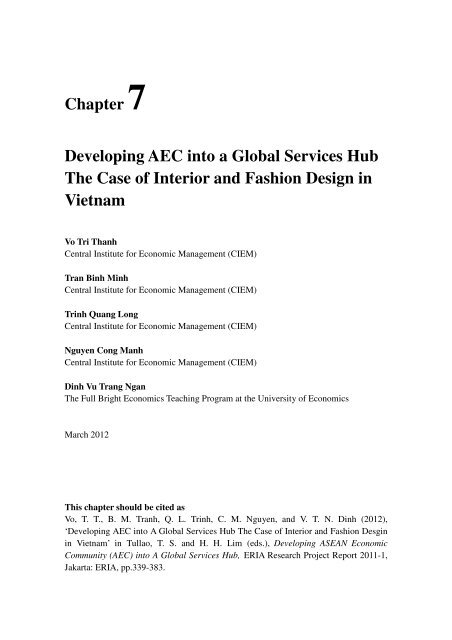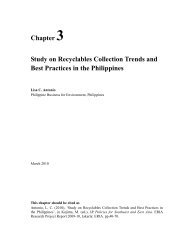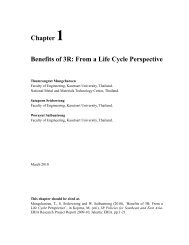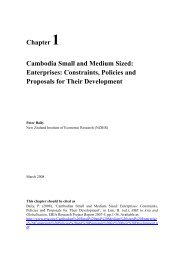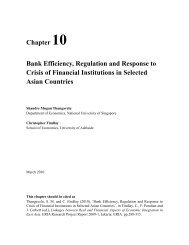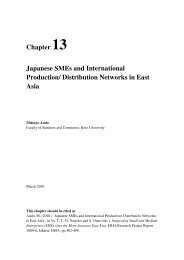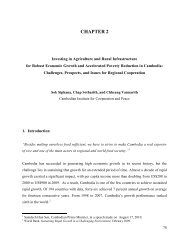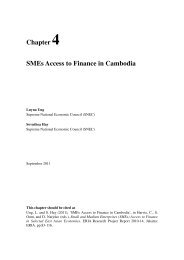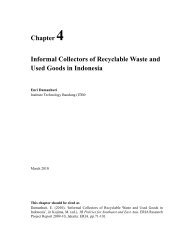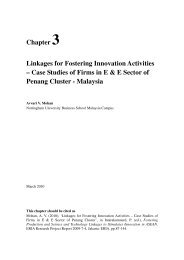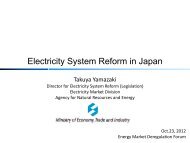Chapter 7-Vietnam's Report on Creative Services - ERIA
Chapter 7-Vietnam's Report on Creative Services - ERIA
Chapter 7-Vietnam's Report on Creative Services - ERIA
You also want an ePaper? Increase the reach of your titles
YUMPU automatically turns print PDFs into web optimized ePapers that Google loves.
<str<strong>on</strong>g>Chapter</str<strong>on</strong>g> 7Developing AEC into a Global <strong>Services</strong> HubThe Case of Interior and Fashi<strong>on</strong> Design inVietnamVo Tri ThanhCentral Institute for Ec<strong>on</strong>omic Management (CIEM)Tran Binh MinhCentral Institute for Ec<strong>on</strong>omic Management (CIEM)Trinh Quang L<strong>on</strong>gCentral Institute for Ec<strong>on</strong>omic Management (CIEM)Nguyen C<strong>on</strong>g ManhCentral Institute for Ec<strong>on</strong>omic Management (CIEM)Dinh Vu Trang NganThe Full Bright Ec<strong>on</strong>omics Teaching Program at the University of Ec<strong>on</strong>omicsMarch 2012This chapter should be cited asVo, T. T., B. M. Tranh, Q. L. Trinh, C. M. Nguyen, and V. T. N. Dinh (2012),‘Developing AEC into A Global <strong>Services</strong> Hub The Case of Interior and Fashi<strong>on</strong> Desginin Vietnam’ in Tullao, T. S. and H. H. Lim (eds.), Developing ASEAN Ec<strong>on</strong>omicCommunity (AEC) into A Global <strong>Services</strong> Hub, <strong>ERIA</strong> Research Project <str<strong>on</strong>g>Report</str<strong>on</strong>g> 2011-1,Jakarta: <strong>ERIA</strong>, pp.339-383.
Figure 1: UNCTAD Classificati<strong>on</strong> of the <strong>Creative</strong> IndustriesAccording to UNCTAD, the creative industries: (i) are the cycles of creati<strong>on</strong>,producti<strong>on</strong> and distributi<strong>on</strong> of goods and services that use creativity and intellectualcapital as primary inputs; (ii) c<strong>on</strong>stitute a set of knowledge-based activities, focused <strong>on</strong>but not limited to arts, potentially generating revenues from trade and intellectualproperty rights; (iii) comprise tangible products and intangible intellectual or artisticservices with creative c<strong>on</strong>tent, ec<strong>on</strong>omic value and market objectives; (iv) stand at thecrossroads of the artisan, services and industrial sectors; and (v) c<strong>on</strong>stitute a newdynamic sector in world trade. They are comprises of four groups, including heritage,arts, media and functi<strong>on</strong>al creati<strong>on</strong>s (Figure 1). Lying under the functi<strong>on</strong>al creati<strong>on</strong>group, the design industries include of interior, graphic, fashi<strong>on</strong>, jewellery and toys. It isdefined as “the creati<strong>on</strong> and development of c<strong>on</strong>cepts and specificati<strong>on</strong> that optimize thefuncti<strong>on</strong>s, and value the apperance of products and systems for the mutual benefit ofusers and manufacturers” 2In Vietnam, creative industry is a new c<strong>on</strong>cept and has not yet been appeared in theclassificati<strong>on</strong> of official statistics. Within the scope of this paper, the fashi<strong>on</strong> design andinterior design is c<strong>on</strong>sidered as inputs in its respectively textile and garment industriesand wood products processing and furniture manufacturing sector. They are regarded as2 According to the definiti<strong>on</strong> of the Industrial Designers Associati<strong>on</strong> of America, the AmericanInstitiet of Graphic arts and the Design Council, L<strong>on</strong>d<strong>on</strong>.340
services, which can not be seperated and not possible to isolate the design input fromthe final products, namely apparels, wood products and furniture. Therefore, the datafor the industries of textile and garment, as well as wood products and furnituremanufacture reflects the total value of final products, not the design c<strong>on</strong>tent.This paper c<strong>on</strong>centrates <strong>on</strong> the two sub-sector of interior and fashi<strong>on</strong> design inVietnam, which is built up<strong>on</strong> the findings and recommendati<strong>on</strong> from the nati<strong>on</strong>al surveywith key different stakeholders in these sectors. In resp<strong>on</strong>ding to the need ofunderstanding the development of ASEAN Ec<strong>on</strong>omic Community into a global hub ofservices, the paper also provides some insights into the sectors, the profile of firms inthe sectors, the characteristics that they owns, the SWOT analysis of the sector andsome policy recommendati<strong>on</strong> drawn from the survey.1. Some Overview of the Ec<strong>on</strong>omyDuring the last ten year, Vietnam’s ec<strong>on</strong>omy has been c<strong>on</strong>sidered as <strong>on</strong>e the fastmovingec<strong>on</strong>omy with positive growth rate. During 2006-2010, the average growth rateis estimated at 7 percent, higher than that of the countries in the regi<strong>on</strong> 3 . (Figure 2)Figure 2: Vietnam’s Ec<strong>on</strong>omic Growth3 According to ADB, during 2006-2010, the average growth rate of ASEAN countries is 5.6 percent,of which Thailand is at 3.6 percent, Malaysia at 4.5 percent, Philippines at 4.9 percent, Ind<strong>on</strong>esia at5.7 percent and Singapore at 6.5 percent.341
Source: General Statistic Office, 2011Although being affected by the global crisis and ec<strong>on</strong>omic downturn, the growthrates in 2008-2010 have been at 6.31 percent in 2008, 5.32 percent in 2009 and 6.78 in2010. By that, the ec<strong>on</strong>omic scale and producti<strong>on</strong> capacity has been <strong>on</strong> the move. TheGross Domestic Product (GDP) at c<strong>on</strong>stant price has been doubled in 2010 (ascompared to that of 2000) and in real term, it is 3.2 times bigger than that of 2000,attaining at USD 101.6 billi<strong>on</strong>. GDP per capita in 2010 (in USD equivalent) has reachedat USD 1,168, overcoming the level of low-income developing country.The growth rates of the three sectors – i.e. agriculture-forestry-fishery, industryc<strong>on</strong>structi<strong>on</strong>,and services have maintained steady growth rate. The stable developmentof the agricultural sector has c<strong>on</strong>tributed to the assurance of nati<strong>on</strong>al food security, andhas played an important role in poverty reducti<strong>on</strong> in the rural areas. The industry andc<strong>on</strong>structi<strong>on</strong> sector has maintained high growth rate, in spite of being affected by theec<strong>on</strong>omic downturn in 2008. In 2010, the growth rate of this sector has reached at 15.3percent. The services sector has been at the fastest growing sector, with expansi<strong>on</strong> ofmarket and the rapid development of tourism, transportati<strong>on</strong>, and telecommunicati<strong>on</strong>.Figure 3: Import and Export, 1995-2010Source: General Statistic Office, 2011342
The export growth rate has been <strong>on</strong> the increase, except for 2009 (decrease by 8.9percent) due to the global crisis and ec<strong>on</strong>omic downturn. The average growth rate for2006-2010 has been at 17.3 percent, higher than the planned figure. However, inresp<strong>on</strong>se to domestic producti<strong>on</strong>, trade deficit has been at the average of 22.4 percent.With the c<strong>on</strong>trolling of import and some import restricted policies, the trade deficit in2010 has been decreased to 17.5 percent. The export of services has been at highgrowth rate, attaining an average of 11.8 percen/year.Table 1: Some Main Exported GoodsUnit: milli<strong>on</strong> USDNo. Product (mill USD) 2005 2006 2007 2008 2009 20101 Crude oil 7373.5 8312.0 8487.6 10356.8 6194.6 4957.62 Coal 669.9 914.8 999.8 1388.5 1316.6 1610.73Electr<strong>on</strong>ics, computersand parts 1427.4 1807.8 2165.2 2640.3 2763.0 3590.24 Articles of plastic 357.7 452.3 709.5 933.7 867.4 1049.35Electrical wire andcable 518.2 705.7 882.3 1009.0 891.8 1311.16Bags, pockets, wallets,hats and umbrellas 470.9 502.1 627.1 773.1 824.1 958.77 Footwear 3038.8 3595.9 3999.5 4769.9 4071.3 5122.38Textile and sewingproducts 4772.4 5854.8 7732.0 9120.5 9065.6 11209.79 Pottery and glassware 255.3 274.4 334.9 344.3 267.2 316.910Fresh, processedvegetables and fruit 235.5 259.1 305.6 406.5 438,9 450.5343
11 Pepper 109.9 114.8 83.0 90.3 134.0 117.012 Coffee 912.7 980.9 1232.1 1060.9 1183.0 1218.013 Rubber 554.1 703.6 715.6 658.7 731.0 782.014 Rice 5254.8 4642.0 4580.0 4744.9 5969.0 6886.015 Cashew nut 109.0 127.7 154.7 160.8 176.0 195.016 Tea 91.7 105.4 115.7 104.7 135.0 137.017Wood and woodenproducts 1561.4 1943.1 2384.6 2767.2 2989.3 3435.618 Fishery products 2732.5 3358.0 3763.4 4510.1 4255.3 5016.3Source: General Statistic Office, 2011Table 1 shows the main exported goods for Vietnam in some recent years. Exceptfor some agricultural and fishery products, such as rice, coffee, vegetables, the main andleading group of products in the list can be named as textiles and sewing products, andfootwear, showing the competitive advantages of Vietnam in manufacturing industries.A report by the Central Institute for Ec<strong>on</strong>omic Management has shown that themanufacturing industries has accounted for nearly 70 percent of the Vietnam’s export in2010, valuing at USD 48.8 billi<strong>on</strong>, increased by 35 percent as compared to that of 2009.This is c<strong>on</strong>sidered as the highest growth and key industries in the export structure of thecountry. The textiles and garment sectors has been the first industries in the list,reaching an average of almost USD 1 billi<strong>on</strong>/m<strong>on</strong>th. Wood and wooden products alsoappears in the list of top ten exported goods in Vietnam, amounting at USD 3,435.6milli<strong>on</strong> in 2010.344
2. Profile of Firms in the Selected Sectors2.1. Fashi<strong>on</strong> Design and the Textile and Garment sectorThere has been no seperated fashi<strong>on</strong> design sub-sector in the manufacturing sectorin Vietnam. At present, the fashi<strong>on</strong> design work is set up as a part/sessi<strong>on</strong> of producti<strong>on</strong>in the textile and garment, therefore there has been no clear data for the fashi<strong>on</strong> designin particular. However, realizing the close linkage and the important of fashi<strong>on</strong> designin the textiles and garment sector, the paper focus <strong>on</strong> proving an overview of the textilesand garment sector as a proxy for fashi<strong>on</strong> design.In some recent years, the textile and garment industry has significant growth rate ofabout 20 percent/year, export value has accounted for about 15 percent of the totalexport of the country. The gross output of the industry has increased 17.9 percent in2008 (as compared to that of the 2007). Main products has been <strong>on</strong> the increase withtextile growth of 11 percent, finished cloth of 8.9 percent, knitting clothes of 8.8percent, and ready-made clothes of 12.6 percent. The significant development of thetextile and garment sector has brought about the result that Vietnam has become <strong>on</strong>e ofthe nine leading countries in textile and garment export, out of the 153 textile andgarment export countries. (VINATEX, 2009)Since the implementati<strong>on</strong> of the VN-US Bilateral Trade Agreement and the fullymembership of the World Trade Organizati<strong>on</strong>, the share and market of Vietnam’sgarment has been <strong>on</strong> the move. The US is leading market with its share of 57.7 percentin 2008, following by EU and Japan.2.2. Some Main Characteristic of the Textile and Garment SectorDuring 2005-2009, the number of enterprises in the textiles and garment industrieshas increased rapidly, almost doubled after five years. The total number of textileenterprises and garment enterprises in 2009 were 2,027 and 3,451 respectively.However, if the number of enterprises in the manufacturing sector accounted for about20 percent of the total enterprises in the period, the textile enterprise <strong>on</strong>ly accounted forabout 4.5 percent and garment enterprise of 7.5 percent. In total, the textile and garment345
industry has accounted for 12 percent of the total enterprises in the manufacturing sectoror <strong>on</strong>ly nearly 2.5 percent of the total enterprises in the ec<strong>on</strong>omy. (Table 2)Table 2: Number of Enterprise in the Textile and Garment Industry (as at 31/12)Ec<strong>on</strong>omic activity 2005 2006 2007 2008 2009Total no. of enterprises 112,950 131,318 155,771 205,689 248,842Manufacturing 24,017 26,863 31,057 38,384 44,707Manufacture of textiles 1,046 1,250 1,367 1,577 2,027Manufacture of apparel 1,745 1,958 2,352 3,174 3,451Source: Enterprise survey, GSO 2011Figure 4and figure 5 present the number of enterprises in the textile and garmentindustry by size of employees with two way of disaggregati<strong>on</strong>, either by number ofemployees or by size of employees. According to the classificati<strong>on</strong> of the GeneralStatistics Office, the micro enterprises are those having less than 10 employees, small ofless than 49 employees, medium of less than 299 employees and large enterprises arethe rest. Following this classificati<strong>on</strong>, in the textile industry, the micro and smallenterprises have accounted for a largest share, with the c<strong>on</strong>centrati<strong>on</strong> of the 10-49-employees enterprises. Medium and large enterprises has accounted for <strong>on</strong>e fifth of thetotal enterprises, 18.5 percent in 2005 and up to 21.1 percent in 2009.346
Figure 4: Number of Enterprises by Size of Employees in the Textile IndustrySource:Enterprise survey, GSO 2011The garment industry also shares the same characteristic with textile industry. Smallenterprises, having 10-49 employees, has largest share during the 2005-2009, which was48.3 percent in 2005 and 39.4 percent in 2009 respectively. The micro enterprises haveincreased after five years, from 20.5 percent in 2005 up to 39.9 percent in 2009. Inc<strong>on</strong>trast with this, large enterprises have been <strong>on</strong> the decrease, from 25.2 percent in2005 to 16.7 percent in 2009. The garment industry seems bigger than textile industryin terms of employees where there were 13 large enterprises with more than 5,000employees. (Figure 4)347
Figure 5: Number of Enterprises by Size of Employees in the Garment IndustrySource:Enterprise survey, GSO 2011With regards to the size of capital, small enterprises are those having capital of lessthan VND 20 billi<strong>on</strong>, medium of 20 to less than VND 100 billi<strong>on</strong>, and the above arelarge enterprises (Figure 4). It is clearly seen in figure 6 and 7that the small enterpriseshave played a big part in both textile and garment industry, with 76.4 percent in 2005and 79.1 percent in 2009 and 83.8 percent in 2005 and 83.7 percent in 2009respectively. The largest share am<strong>on</strong>g them is VND 1-less than 5 billi<strong>on</strong> enterprise.The medium enterprises has accounted for 14.1 percent in 2009 for the textile industrywhile that of the garment industry was 12.1 percent. Large <strong>on</strong>es accounted for <strong>on</strong>lysmall share of 6.8 percent and 4.1 percent respectively in 2009.348
Figure 6: Number of Enterprise by Size of Capital in the Textile IndustrySource:Enterprise survey, GSO 2011349
Figure 7: Number of Enterprises by Size of Capital in the Garment IndustrySource:Enterprise survey, GSO 2011Of all the total number employees working in registered enterprises, the workers inmanufacturing sector has been <strong>on</strong> the increase in 2005-2009 (from more than 3 milli<strong>on</strong>employees in 2005 to more than 4 milli<strong>on</strong> in 2009)and has accounted for a largeproporti<strong>on</strong>, nearly 50 percent of the total. As menti<strong>on</strong>ed above, if the number ofenterprises has accounted for <strong>on</strong>ly 12 percent, the number of employees in the textileand garment industry has accounted for a total of 23.3 percent of the manufacturingsector in 2009, of which the textile industry accounted for <strong>on</strong>ly 4.8 percent (198,371employees) while that of the garment industry was 18.5 percent (764,879 employees) in2009. (Table 3)350
Table 3: Number of Employees in the Textile and Garment IndustrySector 2005 2006 2007 2008 2009Total 6,237,396 6,715,166 7,382,160 8,154,850 8,921,535Manufacturing 3,099,386 3,401,627 3,773,533 3,943,221 4,133,943Textiles 188,365 203,829 195,139 179,076 198,371Garment 511,278 585,414 706,093 758,274 764,879Source:Enterprise survey, GSO 2011In general, it can be seen that the textile and garment industry comprises of smallenterprise, with less than 50 employees and VND 20 billi<strong>on</strong>. They are paid attenti<strong>on</strong> todue to its original nature of taking advantage of the cheap labor resources for processingexport. The total number workers was almost 1 milli<strong>on</strong> workers in 2009, however, it isnot stable. The main reas<strong>on</strong> comes from its low income for the workers, leading to thefact that they are ready to move to other higher income industry. Therefore, in thetextile and garment sector, although enterprises have increased their salary and benefits,the number of workers dropping out of the sector has increased as compared to newlyrecruited <strong>on</strong>es.Another feature that the Vietnam’s garment possesses is the simple manufacture ofexport for foreign partners. Through our interview with some big enterprises in thegarment sector, although they have their own designers, the ability of designing as wellas capacity of producti<strong>on</strong> is still limited. In some recent years, some small enterpriseswhose are towards the domestic market have their own design and market share,especially for medium and high income class, namely NEW NEM, IVY Moda and EvaDe Eva. Even big enterprises such as Garco 10, Viet Tien (for garment) and Ph<strong>on</strong>gPhuand Viet Thang(for textile) have their own designing department, the model and designare not fully <strong>on</strong> their own and for their own market. Most of the design patterns aresomewhat imitate the internati<strong>on</strong>al trends or copying from the orders of theirinternati<strong>on</strong>al partners.The leading actor in the market is Vietnam Nati<strong>on</strong>al Textile and Garment Group(VINATEX), a big complex that comprises of the mother company VINATEX and its120 joint-stock members. It also includes 5 textile and garment school, which havetheir own fashi<strong>on</strong> design divisi<strong>on</strong>, and a nati<strong>on</strong>al Vietnam Fashi<strong>on</strong> Design Institute.Despite the purpose of creating opportunities for talented designers to meet apparelfirms and extending support to those with str<strong>on</strong>g potentiality in product development,351
the Vietnam Fashi<strong>on</strong> Design Institute’s role in the sector is blurred. For the first time <strong>on</strong>23 December 2011, the Vietnam Fashi<strong>on</strong> Design Institute has their own study <strong>on</strong> “Colortrend for fashi<strong>on</strong> in 2012”, which is c<strong>on</strong>sidered as the first professi<strong>on</strong>al and practicalstudy, both for the textile and garment industry as well as for c<strong>on</strong>sumer. However, <strong>on</strong>eof the regular activities that have been carried out by the Vietnam Fashi<strong>on</strong> DesignInstitute is the organizati<strong>on</strong> of Vietnam Fashi<strong>on</strong> Weeks and annual fashi<strong>on</strong> designcompetiti<strong>on</strong>.At this moment, <strong>on</strong>ly five textile and garment company have been listed <strong>on</strong> thestock market, namely Thanh C<strong>on</strong>g Textile and Garment Join-Stock Company (TCM),Thai Nguyen Investment and Trading Company (TNG), BinhThanh Joint-StockCompany (GIL), Saig<strong>on</strong> Garment Joint-Stock Company (GMC) and PhuThinh – NhaBe Garment Joint-Stock Company (NPS), of which 3 are listed <strong>on</strong> the Ho Chi MinhStock Exchange and 2 are listed <strong>on</strong> Hanoi Stock Exchange. Out of the listedcompanies, TCM is the biggest company with the charter capital of VND 447 billi<strong>on</strong>and the producti<strong>on</strong> capacity of 20 milli<strong>on</strong> products per year. (Table 4)Table 4: Some criteria of the listed companies (as at June 2011)Code Main product Capacity (mil.products/years)Total Asset(VND bil.)Chartercapital(VND bil.)Rate ofreturn (%)TCM Cott<strong>on</strong> clothes 20 2,021 447.4 9.47GMC Sports, jacket,short465.2 88.7 5.28GIL Clothes, handbags 1.3 616.8 127.2 9.42TNG Jacket, trouser 10 881.8 134.6 3.37NPS Jacket, trousers 82.4 7.99 7.99Source: C<strong>on</strong>solidated from HNX and HSXThe last layer in the profile of firms are micro and small enterprises which are themajority of the sector, whose activities are processing for bigger enterprises and nothaving frequent orders from internati<strong>on</strong>al trading partners. For those enterprises, it is352
not necessary to have separate design divisi<strong>on</strong> because it is not as important as directworkers.In c<strong>on</strong>clusi<strong>on</strong>, there has been no official data <strong>on</strong> the fashi<strong>on</strong> design aspect of thetextile and garment industry, it is difficult to have c<strong>on</strong>crete comments <strong>on</strong> this part. Oneof the finding through our interview with key stakeholders and some apparel companyis that even the textile and garment companies are small and mostly processing export,the design divisi<strong>on</strong> seem to be blurred. Most of the design patterns are influenced bytheir internati<strong>on</strong>al trading partner as well as the internati<strong>on</strong>al trends. The very smalldomestic market share is dominated by fragmented and single fashi<strong>on</strong> designer, such asNEW NEM, IVY Moda, Eva De Eva, FOCI, NINOMAXX,… The enterprises in thesector are mainly processing export; their own design divisi<strong>on</strong>s are still finding a marketroom and c<strong>on</strong>sumer taste in affirming themselves.2.3. Interior Design and the Wood Processing and FurnitureIn similarity with the fashi<strong>on</strong> design and as menti<strong>on</strong>ed in the introducti<strong>on</strong> part of thepaper, the interior design str<strong>on</strong>gly associated with the manufacture of wood and woodproducts and the manufacture of furniture as classificati<strong>on</strong> by the Vietnam GeneralStatistic Office. Table 5 shows the overview of enterprises that are in the two sectors.Table 5: Number of Enterprises in the Wood Products and FurnitureEc<strong>on</strong>omic activity 2005 2006 2007 2008 2009Total no. of enterprises 112,950 131,318 155,771 205,689 248,842Manufacturing 24,017 26,863 31,057 38,384 44,707Manufacture of wood 1,710 2,032 2,390 3,098 3,562and wood productsManufacture offurniture1,796 1,921 2,343 3,126 3,930Source:Enterprise survey, GSO 2011There has been a significant development of the number of enterprises in themanufacture of wood and wood products and manufacture of furniture during 2005-2009. The number of enterprises has been doubled after five year, from a total of 3,506in 2005 to 7,592 in 2009. In other words, of all the registered companied, themanufacture of wood and wood products and manufacture of furniture has accountedfor <strong>on</strong>ly 3 percent in 2009, however, out of the manufacturing sector, they havec<strong>on</strong>tributed to 16.76 percent of the actors in the sector.353
Figure 7: Number of Enterprise by Size of Employees, 2005-2009Source:Enterprise survey, GSO 2011The number of enterprises of the manufacture of wood and wood products ispresented in the left-hand side of figure 7 and the manufacture of furniture is <strong>on</strong> theright-hand side. It is clearly seen in the figure that the majority of enterprises are smalland medium in terms of employees, i.e. having less than 50 employees. Enterprises inthe manufacture of furniture seem a little bit bigger with some bigger share of largeenterprise, with 6.8 percent or 269 enterprises in 2009.354
Figure 8: Number of Enterprises by Size of CapitalSource:Enterprise survey, GSO 2011Figure 8 shows that of all the enterprises that are active in the manufacture of woodand wood products (the left-hand side) and the manufacture of furniture (right-handside), the majority are small with the capital of less than VND 20 billi<strong>on</strong>, which is about93 percent for those operating in the manufacture of wood and wood products and about83 percent for those operating in the manufacture furniture. The large enterprises, interm of capital with more than VND 100 billi<strong>on</strong>, <strong>on</strong>ly accounted for a small share, 1percent for the manufacture of wood and wood products and 4.3 percent formanufacture of furniture.355
Table 6: Number of Employees, 2005-2009Sector 2005 2006 2007 2008 2009Total 6,237,396 6,715,166 7,382,160 8,154,850 8,921,535Manufacturing 3,099,386 3,401,627 3,773,533 3,943,221 4,133,943Wood and wood products 113,979 112,440 124,477 130,443 126,940Furniture 260,235 320,147 356,500 352,247 355,539Source:Enterprise survey, GSO 2011As at 31 December 2009, the total number of employees working in themanufacture of wood and wood products and manufacture of furniture was amounted at126,940 and 355,539 pers<strong>on</strong>s respectively, accounting for 4.8 percent and 18.5 percentof the wider manufacturing sector. That is, in total, the two sectors have c<strong>on</strong>tributed upto 23.3 percent of the employees in the manufacturing sector or 5.4 percent of theemployees in the registered enterprises sector.One comm<strong>on</strong> feature of the manufacture of wood, wood products and furniture isthe small and labor-intensive enterprise, which is also seen in the textile and garmentindustry. In some recent year, together with the development of society and increasingdemand in having more luxurious wood furniture for medium and high income class inthe country, there has been a significant number of interior design enterpriseestablished. In additi<strong>on</strong> to that, a numbers of individual interior designers have beendeveloped to meet the niche demand of the market.Figure 9: Export Value and Import Value of the Wood Products and FurnitureIndustry, 2005-2011400035003000250020001500100050002005 2006 2007 2008 2009 2010 2011Export valueImport valueSource: MOIT, 2012356
Figure 9 has shown the increasing trend of the wood products and furniture during2005-2011. In spite of it, the wood products and furniture processing sector hasexperienced from the overall impacts of global crisis and ec<strong>on</strong>omic downturn in 2008and 2009. Therefore, the total export value of the sector in 2009 has decreased by 8.25percent as compared to that of 2008. However, since the end of 2009, more orders havecome into the sector, and new market has been developed, such as Russia, LatinAmerica and Middle East, leading to an increase of 5.3 percent and amounting to USD2.735 billi<strong>on</strong>.Figure 10: Export Structure by Market as at end of 20112011Netherlands, 1.7%France, 2.9%Australia, 2.3%Canada, 2.3%Others, 13.6%USA, 35.6%Germany, 4.2%Great Britain, 4.6%Korea, 5.1%Japan, 15.5%China, 12.2%Source:MOIT, 2012The break-down of export of wood product and furniture industry by market sharehas been shown in figure 10, where USA has been the largest with its market share of35.6%, following by Japan (15.5%), China (12.2%). New other markets have beenemerged in some recent years and still are <strong>on</strong> the increase (such as Great Britain andGermany).357
Table 7: Three main export markets of wood products and furniture industry,2006-2011 (milli<strong>on</strong> USD)Market 2006 2007 2008 2009 2010 2011USA 744.1 944.3 1,045 1,100 1,400 1,423EU 500.2 633.1 791.8 545 644.7 519.5Japan 286.8 300.6 365.9 355.4 454.6 585Source: Ministry of Industry and Trade, 2011The leading market for wood products and wood furniture industry has beenc<strong>on</strong>firmed in table 7 with the three main export markets. Accounting for nearly 36% ofthe total export, the export value to the US market has amounted to USD 1,423 milli<strong>on</strong>in 2011, while that of the EU market and the Japan has been at USD 520 milli<strong>on</strong> andUSD 585 milli<strong>on</strong> respectively.Figure 11: Export structure by type of products in 2011Kitchen furnitureOffice furniture3.3%6.1%Flooring11.0%Others2.4%Bedroom furniture25.3%Wood chip14.1%Chairs18.0%Living and diningroom furniture19.8%Source: Ministry of Industry and Trade, 2011With regards to type of products, in 2011, the bedroom furniture and living/diningroom furniture has accounted for the highest percentage of export, with 25.3% and19.8% respectively. In total, the furniture has account for larger share in total export,with the sub-total of up to 54.5%, while the wood products account for the rest, withthree type of chairs (18%), wood chip (14.1%) and flooring (11%).In spite of no official data for setting up a profile of firms in the sector, the paperhas developed its own firm profile based <strong>on</strong> observati<strong>on</strong> and interview with keystakeholders.358
The leading companies in the interior design industry seems to be the AAC<strong>on</strong>structi<strong>on</strong> and Architect Joint Stock Company (AA Corporati<strong>on</strong>) and the Tru<strong>on</strong>gThanh Furniture Coprorati<strong>on</strong>. The AA Corporti<strong>on</strong>was established in 1990 in theproducti<strong>on</strong> of wood products and luxury interior furniture. At the moment, with morethan 2,000 employees, the company has supplied both for domestic and internati<strong>on</strong>almarket. More than 50 percent of its producti<strong>on</strong> are for export, AA Corporatioinproduces both ODM (Original Design Manufacturer) and OEM (Original EquipmentManufacturer) to big market such as the US, UK, German, Japan, Srilanka andCambodia. Employing traditi<strong>on</strong>al techniques in water gilding, marquetry, carving andhand polishing, within its producti<strong>on</strong> facilities for ensuring their products.For thedomestic market, AA Corporati<strong>on</strong> has been known through its brand name of AADécor, Bellavita, NhaXinh, BoC<strong>on</strong>cept, Tekni<strong>on</strong>. The AA Corporati<strong>on</strong> has its owninterior design staffs, thatmake their own study <strong>on</strong> the market demand and individualcustomers. With a network of 3 factories and certified by ISO 9001 as well as by COCto produce Forest Stewardship Council (FSC) Products, AA Corporati<strong>on</strong> is experiencedin producing both loose furniture as well as architectural mill work products used in fitout projects.Tru<strong>on</strong>g Thanh Furniture Corporati<strong>on</strong> (TTF) is <strong>on</strong>e of the leading domesticcompanies, which is in the 3 rd positi<strong>on</strong> in terms of export value, after two foreigninvestedenterprises. The foundati<strong>on</strong> of TTF is a wood processing workstati<strong>on</strong> inDakLak, a province in the Central Highlands, which was established in 1993.Currently, TTF is the leading company in the wood manufacturing and is the biggestenterprise out of the three listed companies in the stock market. The company owns anetwork of 8 wood processing manufacturers in Ho Chi Minh City, Binh Du<strong>on</strong>g,DakLak and Phu Yen. In 2010, there are three groups of products in the Corporati<strong>on</strong>,namely the exterior furniture (accounted for 37 percent), interior furniture (51 percent)and wood floor (12 percent). The export value of the company has amounted up to 85percent of the total producti<strong>on</strong> in 2008. However, in some recent years, realizing theincreasing demand of the sector, TTF has paid more attenti<strong>on</strong> to the domestic market,leading to 30 percent of domestic share in 2010.The sec<strong>on</strong>d layer of actors in the interior design industry is the three listedcompanies in the stock exchange market, namely DucThanh Wood Processing359
Company (GDT), Thuan An Wood Processing Joint-Stock Company (GTA), andSAVIMEX (SAV). They are specialized in wood and wood products processing as wellas furniture manufacture. However, the producti<strong>on</strong> is <strong>on</strong> average, 65 percent fordomestic market and 35 percent for export.Table 8: Some Selected Criteria of the Listed CompaniesCode Market capitalizati<strong>on</strong> 4(VND billi<strong>on</strong>)Total Revenue (VNDbilli<strong>on</strong>)Profit after taxes(VND billi<strong>on</strong>)GTA 119.6 286.4 9.2GDT 224.0 174.3 30.8SAV 318.8 403.4 14.6TTF 747.2 1,901.7 23.1Source: C<strong>on</strong>solidated from HNX and HSXThe sec<strong>on</strong>d layer also experienced some other companies that have not been listedin the stock market but have medium operati<strong>on</strong>al activities such as Hoang AnhGia LaiFurniture (under the big Hoang AnhGia Lai corporati<strong>on</strong>), Starwood Furniture (a 100foreign-invested company), Thomps<strong>on</strong> Furniture (a 100% foreign-invested company).The third layer comprises of a variety of small enterprises that has accounted forlarge share in the sector, more than 80 percent of the total enterprises. Their purpose ofoperati<strong>on</strong> is toward medium and lower income class in society. However, theseenterprises do not have their own design staffs. The patterns and design are copied andadjusted from the existing <strong>on</strong>es and the quality is not as good as the bigger <strong>on</strong>es.2.4. Some Comm<strong>on</strong> Characteristics of Interior and Fashi<strong>on</strong> Design in VietnamThe creative industries comprise of variety of types of development with specialcharacteristics and different from the normal industries. Known as the nurturingindustries in Vietnam, interior design and fashi<strong>on</strong> design have some followingcharacteristics:4 As at the end of the first quarter in 2010.360
- Products of the interior and fashi<strong>on</strong> design c<strong>on</strong>tain the factor of creative,therefore, to some extent, they are uncertainty. Designer and producers can notbe sure of the profit of their products when they are sold in the market.- Because the interior and fashi<strong>on</strong> design is at the early stage of development,there is no leading trend in the sectors, they are being influenced by internati<strong>on</strong>altrend, which is sometimes not suitable with Vietnam’s traditi<strong>on</strong> and culture, andcan not be c<strong>on</strong>sumed.- There is “colorful” team of designers that are finding a place in the market.Although some of them are known with certain products, the coordinati<strong>on</strong>am<strong>on</strong>g designers is still weak and c<strong>on</strong>flict is a must. However, this is a comm<strong>on</strong>characteristic of not <strong>on</strong>ly the creative industries, but also other business sectors.- The interior design sector has not been clearly defined. It is still mixed up andc<strong>on</strong>sidered as <strong>on</strong>e comp<strong>on</strong>ent of the larger c<strong>on</strong>structi<strong>on</strong> sectors. That is also areas<strong>on</strong> why there has not any development plan yet for this sector.- There is variety of products and they are different from each other. Thischaracteristic can be interpreted to, in <strong>on</strong>e hand, meet the increasing anddifferent demand of the society, and to c<strong>on</strong>firm the characteristic of immaturesectors.- The durableness of the sectors is different. Interior design can possess thischaracteristic, but it is not true for the fashi<strong>on</strong> design.- The lifetime of a product is short. C<strong>on</strong>taining the characteristic of creativeness, ittakes time to produce <strong>on</strong>e product, and it is not sure of the delay in producti<strong>on</strong>.It is appropriate with fashi<strong>on</strong> design sector.In the current c<strong>on</strong>text, the development of interior and fashi<strong>on</strong> design inVietnam is depended <strong>on</strong> some following trends:- Being influenced and led by developed market such as France, the UK, China,and the US.- The internati<strong>on</strong>alism and localism is parallel existed. It is reflect in most of thestage of producti<strong>on</strong>, not <strong>on</strong>ly included in building market and c<strong>on</strong>sumers,development and distributi<strong>on</strong>, but also in developing idea into products, which isknown as individual creativeness.361
- The sector is developing towards market-based demand.- Within the industries, the creativeness of individual designers and groups isincreasing, which play an important role of ideas and new approaches andincreasing the calue added of products and services provided for c<strong>on</strong>sumers.- Digitalizati<strong>on</strong> is key in the design sector due to the str<strong>on</strong>g development ofinformatics’ infrastructure.- The supporting industries is developing3. Policy Review3.1. Over Business Climate of the SectorsThe new Enterprise Law and Investment Law in 2005The Law <strong>on</strong> Enterprises, which took effect <strong>on</strong> 1 July 2006 (replacing the previousEnterprise Law 1999 and adjusted State-owned Enterprise Law 2003) applies to alldomestic, foreign-invested and State-owned enterprises established in Viet Nam andspecifies voting procedures and quorum requirements in both limited liabilitycompanies and joint stock companies. The Investment Law, also coming into effectsince 1 July 2006 and replacing the Law <strong>on</strong> Incentives for Domestic Investment and theForeign Investment Law 2000, promulgate comm<strong>on</strong> applicati<strong>on</strong> <strong>on</strong> investmentactivities, regardless of foreign or domestic sources of capital. These changes havebeen viewed as breakthrough in the ec<strong>on</strong>omic development and thinking and reformprocess of legal and regulatory framework in Vietnam. The enacti<strong>on</strong> of Enterprise Lawand Investment Law in 2005 was implemented as there are additi<strong>on</strong>al c<strong>on</strong>diti<strong>on</strong>spositively affecting the Vietnam ec<strong>on</strong>omic reforms and development. It was the eventthat the country was joining WTO, whilst its ec<strong>on</strong>omy has actually gained goodmomentums with high annual growth rates, thus making foreign investor redirect theircapital flows from other countries into Vietnam. Updated informati<strong>on</strong> shows that FDIin Vietnam has risen with much larger scale and higher speed in comparis<strong>on</strong> withprevious years.362
According to the “Doing Business 2012” report, the ranking of Vietnam’s overallbusiness climate has fallen in 2011 because the country has failed to improve itselectricity system. Also, this <str<strong>on</strong>g>Report</str<strong>on</strong>g> menti<strong>on</strong>s the slow pace of administrative reformsin Vietnam. In general, the Vietnam has just improved <strong>on</strong>ly three out of the ten areasthat the <str<strong>on</strong>g>Report</str<strong>on</strong>g> looked at, including c<strong>on</strong>structi<strong>on</strong> permits, investor protecti<strong>on</strong> andc<strong>on</strong>tract enforcement. A worsening of c<strong>on</strong>diti<strong>on</strong>s was seen in areas such as startingbusiness (licensing), registering property, paying taxes and obtaining credit.However it is believed in Vietnam’s ability to remain competitive and maintainsustainable ec<strong>on</strong>omic growth over the l<strong>on</strong>g term because the Vietnamese government istaking acti<strong>on</strong>s in several key areas, including stabilizing the macroec<strong>on</strong>omicenvir<strong>on</strong>ment in Vietnam, protecting better investor’s rights in particular in the areas oflicensing, protecti<strong>on</strong> of intellectual property rights and efficient enforcement in cases ofIPR violati<strong>on</strong>s, c<strong>on</strong>tinuing the implementati<strong>on</strong> of infrastructure projects andguaranteeing reliable energy supply, improving the quality of labor force by promotinghigher educati<strong>on</strong> and vocati<strong>on</strong>al training, tackling red-tape and corrupti<strong>on</strong> andc<strong>on</strong>tinuing to reduce and simplify administrative burdens <strong>on</strong> all levels (should be at thehigh in the government’s agenda).Over the last years, Viet Nam has greatly benefited from significant foreign directinvestment, triggered up<strong>on</strong> its accessi<strong>on</strong> to WTO and the resulting liberalizati<strong>on</strong> inservices sectors. While Viet Nam, over the last years, has renewed significantly itslegal frameworks, the full and timely implementati<strong>on</strong> of WTO commitments in practicerepresents a fundamental for Viet Nam’s <strong>on</strong>going attracti<strong>on</strong> of FDI in 2012-2015. Infacilitating this, the administrative procedures has improved as the Government hasintroduced and adopted the <strong>on</strong>e-stop-shop approval for investment activities that reducethe time in setting up business, the number of documents required has reducedsignificantly, the licensing regulati<strong>on</strong>s, the opening of a branch, relocating branchprocedures are simplified. Together with the implementati<strong>on</strong> of Enterprise Law, theissuance of guiding decrees and circular has been in progress in further facilitating thebusiness envir<strong>on</strong>ment climate. Recently, the Decree 102/2010/ND-CP <strong>on</strong> 1 st October2010 (in replacement for Decree 139 of 5 th September 2007) has been welcomed by thebusiness community because it clarifies that companies established in Vietnam withforeign ownership of up to 49 percent can enjoy the same investment rules an c<strong>on</strong>diti<strong>on</strong>s363
as those applicable to local companies. C<strong>on</strong>currently, those with foreign ownership ofmore than 49 percent will be subject to same c<strong>on</strong>diti<strong>on</strong>s as applicable to foreigninvestors. This should make the acquisiti<strong>on</strong> and operati<strong>on</strong> of companies with less than49 percent foreign ownership easier. In additi<strong>on</strong> to that, there are some certain areasthat entitled to favorable investment c<strong>on</strong>diti<strong>on</strong>s and incentives through investmentregulati<strong>on</strong>s and tax regulati<strong>on</strong> (import duty and corporate income tax).At the beginning of 2011, the Vietnamese Government announced it would beemphasizing “quality over quantity” where foreign direct investment is c<strong>on</strong>cerned. Thispresumably meant that Viet Nam would be focusing <strong>on</strong> attracting high-technologyvalue-added manufacturing from foreign companies. One important comp<strong>on</strong>ent of thisis the implementati<strong>on</strong> and enforcement of intellectual property rights. The Law <strong>on</strong>Intellectual Property Rights has been the first time passed in 2005 and being effectedfrom 1 July 2006. The issuance of the Law has change the mindset and understandingof people in respecting, encouraging and rewards the products of human mind. Theguiding under-law documents are <strong>on</strong> progress and the enforcement of IPR will helpcreate an envir<strong>on</strong>ment to motivate to produce new ideas and technologies; protectVietnamese c<strong>on</strong>sumers from the danger of counterfeit products and attract moreadvanced foreign technology to Vietnam. However, the enforcement of IPR is still aproblem because the attitude of Vietnamese public toward counterfeiting and IPRinfringement remains ambivalent.Policies related to the development of SMEsThe overall SMEs development plan 2011-2015 is <strong>on</strong> the drafting process.However, the latest seminar <strong>on</strong> recommending for development plan held at end of 2011shows that SMEs in Vietnam, and is small in scale and weak in competiveness. Asurvey carries out by the Ministry of Planning and Investment has revealed that nearly50 percent of SMEs has capital less than VND 1 billi<strong>on</strong>; 75 percent less than VND 2billi<strong>on</strong> and 90 percent less than VND 5 billi<strong>on</strong>. The comm<strong>on</strong> difficulties of SMEsinclude lack of capital and access to land, with the additi<strong>on</strong> comprise of weakmanagement skills, low technology, small and fragmented market and lack of linkageswith big enterprises. This requires a proper plan of amending regulatory framework aswell as support from Government for facilitating the development of SMEs.364
3.2. Policy Review related to the Fashi<strong>on</strong> Design and Interior DesignFashi<strong>on</strong>designFor the large textile and garment sector, the nati<strong>on</strong>al strategy for the development oftextile and garment industry till 2015 and orientati<strong>on</strong> to 2020 has approved by the PrimeMinister in 2008. The overall objectives for development of the industry is to become<strong>on</strong>e of the key industries and <strong>on</strong>e of the leading export industries which meet theincreasing domestic demand, creating jobs as well as increasing the competitiveness andsustainable integrati<strong>on</strong> into the regi<strong>on</strong> and the global. To support for the overallobjectives, the target for development till 2020 has defined the growth rate for annualproducti<strong>on</strong> from 12 percent to 14 percent and for annual export of 15 percent and somemain criteria as follows:Table 9: Some Selected Criteria for the Textile and Garment SectorCriteriaUnitTarget for large industry by2010 2015 20201. Total revenue Milli<strong>on</strong> USD 14,800 22,500 31,0002. Total export Milli<strong>on</strong> USD 12,000 18,000 25,0003. EmploymentThousandpeople2,500 2,750 3,0004. Domestic c<strong>on</strong>tent % 50 60 705. Main products:- Fibre yard 1000 t<strong>on</strong> 20 40 60- Fibre, synthetic fibre 1000 t<strong>on</strong> 120 210 300- Other fiber 1000 t<strong>on</strong> 350 500 650- Cloth Milli<strong>on</strong> m 2 1,000 1,500 2,000- Garment productsSource: VINATAS, 2010Milli<strong>on</strong>products1,800 2,850 4,000365
Policy orientati<strong>on</strong> and recommendati<strong>on</strong> has been developed in the nati<strong>on</strong>al strategy,including the followings:i. Products:C<strong>on</strong>centrate <strong>on</strong> developing and increasing the competitiveness for theexport of garment and textile industry; increase the local c<strong>on</strong>tent forbetter effective producti<strong>on</strong>; pay attenti<strong>on</strong> to fashi<strong>on</strong> design to havespecial and different products and gradually build the trademark forenterprises; increase the adaptati<strong>on</strong> of quality management standard tomeet the requirements of integrati<strong>on</strong>.Encourage domestic and foreign investment in the sector, especially <strong>on</strong>the producti<strong>on</strong> of synthetic fibre, replacing material and supportingindustriesMake a producti<strong>on</strong> plan for the development of exporting cloth with theleading role of the Vietnam Textile and Garment Associati<strong>on</strong>Make a development plan for cott<strong>on</strong> trees.ii.Investment and producti<strong>on</strong> developmentFor garment enterprises: Producti<strong>on</strong> base should be located where thereare favorable resources of labor and transportati<strong>on</strong>. Establish fashi<strong>on</strong>centers, research institute for fashi<strong>on</strong> design, material-providing centersand trading centers in Ha Noi and Ho Chi Minh City and big citiesFor fibre, clothing and dying enterprises: C<strong>on</strong>struct specialized industrialparks and z<strong>on</strong>es which have adequate c<strong>on</strong>diti<strong>on</strong>s for producti<strong>on</strong>.iii.Envir<strong>on</strong>mental protecti<strong>on</strong>Build the Envir<strong>on</strong>mental Assessment <str<strong>on</strong>g>Report</str<strong>on</strong>g> for the Garment and Textileand regulatory framework related to envir<strong>on</strong>mentHave special treatment for serious polluted areas and c<strong>on</strong>struct watertreatment system in garment and textile z<strong>on</strong>es366
Adopt and c<strong>on</strong>duct the Green Producti<strong>on</strong> Program in the sector,encouraging the adopti<strong>on</strong> of ISO 14000 and creating good workingc<strong>on</strong>diti<strong>on</strong>s under SA8000Build and implement the roadmap for technology innovati<strong>on</strong> in the sectortowards envir<strong>on</strong>mental friendlyEnhance the research and study <strong>on</strong> envir<strong>on</strong>mental issuesMeet the requirement of envir<strong>on</strong>ment and technical barriers ininternati<strong>on</strong>al ec<strong>on</strong>omic integrati<strong>on</strong>Interior designAt this moment, there is not clear legal framework for the development of interiordesign industry. It is <strong>on</strong>ly recognized as <strong>on</strong>e comp<strong>on</strong>ent of the broader c<strong>on</strong>structi<strong>on</strong> anddesign sector. Therefore, the existing Law <strong>on</strong> C<strong>on</strong>structi<strong>on</strong> in 2003 is seemed to be thehighest and overall regulatory framework, which c<strong>on</strong>tains <strong>on</strong>e <str<strong>on</strong>g>Chapter</str<strong>on</strong>g> with 2 Items, and16 Articles for the development of the sector. However, there is no clear and targetedarticle <strong>on</strong> the interior design, which is regarded as <strong>on</strong>e part of the architecture design.Some under-law and guiding documents have been issued since the effectiveness of theLaw, but almost nothing touch up<strong>on</strong> the interior design.4. SWOT AnalysisThis secti<strong>on</strong> provides an analysis of the strengths, weaknesses, opportunities, andthreats c<strong>on</strong>fr<strong>on</strong>ting Vietnam’s creative services in the case of interior and fashi<strong>on</strong>design. Our SWOT analysis is drawn from the initial results of our surveys <strong>on</strong> 17resp<strong>on</strong>dents, including managers, designers, entrepreneurs, educators and policymakersfrom Hanoi and Ho Chi Minh City in the designated fields. The list of surveyresp<strong>on</strong>dents is in Appendix 1.367
Our preliminary findings suggest that while the country enjoys a number ofstrengths and opportunities for a thriving creative service industry, at least in the case offashi<strong>on</strong> and interior design, the challenges rooted from fundamental weaknesses areimmense. We identify some of the key issues facing Vietnam, as the nati<strong>on</strong> movesforward in an integrated global ec<strong>on</strong>omy with increasingly sophisticated demands forcreative goods and services. Our SWOT matrix is summarized in Appendix 2.According to UNCTAD’s <strong>Creative</strong> Ec<strong>on</strong>omy <str<strong>on</strong>g>Report</str<strong>on</strong>g> (2010), “Design”, includinginterior, graphic, fashi<strong>on</strong>, jewelry, and toys, is classified as Functi<strong>on</strong>al Creati<strong>on</strong>s, whichcomprises the goods and services that are more demand-driven and services-orientedwith functi<strong>on</strong>al purposes. Four out of seven UNESCO Cities of Design are in Asia(Kobe, Nagoya, Japan, Shenzhen and Shanghai, China). In the area of interior andfashi<strong>on</strong> design, Vietnam is am<strong>on</strong>g the newcomers even compared with countries in theregi<strong>on</strong>. We will examine different factors that may affect the potential development ofthese designing services in Vietnam.4.1. Strengths<strong>Creative</strong> individualsVietnamese people from the ancient times were believed to be skillful, particularlywith their hands, hence the existence of traditi<strong>on</strong>al handicraft villages has beenpersistent until now. There is an innate tendency to create something unique anddifferent from what is seen and learned. Almost every resp<strong>on</strong>dent in our survey wouldagree that there is a large number of very creative individuals in the field of architecture,interior, and especially fashi<strong>on</strong> design. One can go as far as saying “every Vietnameseis an artist”. This creativity, however, exists and is more visible at the individual level.Abundantly dynamic and talented youthVietnam has a populati<strong>on</strong> of nearly 90 milli<strong>on</strong> people. Over half of the labor forceis under the age of 30. It is a country rich in labor and vigor, with great potential inservices or any c<strong>on</strong>sumer markets. According to the most recent Populati<strong>on</strong> Census 5 ,Vietnam has entered a period of “Golden Populati<strong>on</strong>”, during which the proporti<strong>on</strong> of5 Populati<strong>on</strong> Census 2009 <str<strong>on</strong>g>Report</str<strong>on</strong>g>, “Báocáokếtquảchínhthức, tổngđiềutradânsốvànhà ở 1/4/2009,”BanChỉĐạo, Tổngđiềutradânsốvànhà ở trungương, July 2010.368
children below 15 falls below 30%, and the elderly above 65 is below 15% of totalpopulati<strong>on</strong>. With a populati<strong>on</strong> of over 86 milli<strong>on</strong> people, the numbers of people aged15-65, the main c<strong>on</strong>tributi<strong>on</strong> to our labor force has increased to nearly 70%. In otherwords, two thirds of the populati<strong>on</strong> is in their working ages, creating a young andabundant labor force for ec<strong>on</strong>omic development activities. The textile and garmentindustry al<strong>on</strong>e has employed over 3 milli<strong>on</strong> workers, of which over 1.3 milli<strong>on</strong> areindustrial workers, taking up to 10 percent of the total industrial workers nati<strong>on</strong>wide 6 .Educators, managers, and senior designers often commented that there is a youngVietnamese generati<strong>on</strong> of very passi<strong>on</strong>ate so<strong>on</strong>-to-be, or want-to-be designers. Thisgroup of young designers has a str<strong>on</strong>g thrive for knowledge, which they seem not to getfrom arts schools or the traditi<strong>on</strong>al training channels. Many have taken up almost anyopportunities to practice, either by working al<strong>on</strong>gside with the more senior designers inan apprenticeship, or for learning-by-doing purposes. These young designers are said tohave a lot of new and bold ideas. They are also very up to speed with the latest trends,are fully informed about discussi<strong>on</strong>s, events, and demands around the world. They areactive seekers for opportunities to study abroad, participating in designing c<strong>on</strong>tests, orfashi<strong>on</strong> events around the world. They are also very ambitious, with str<strong>on</strong>g desires tobecome internati<strong>on</strong>ally known in the bigger world. If properly trained and motivated,over time with more experience and exposure, these young and energetic designerscould be a great source of growth for the field.Culturally valued detailsOne cultural characteristic has been an excessive focus <strong>on</strong> details, subtlesophisticati<strong>on</strong>, the best, the selected few, over massive producti<strong>on</strong>, or large quantities(“quýhồtinhbấtquýhồđa”). This characteristic is pervasive across all service sectors, butare of particular importance to the designing industries. The attenti<strong>on</strong> and demand fordetail, or detailed differences, serves every market segment, from low to high-endcustomers. There is a great strength in miniscule product differentiati<strong>on</strong> that calls forcreativity.6 Vietnam Textile and Apparel Porter, http://www.vietnamtextile.org.vn.369
4.2. WeaknessesAn uneven playfield for SMEsWhile garment, textile, and furniture manufacturing firms are mostly large <strong>on</strong>eswith a lot of capital and support from the state, interior and fashi<strong>on</strong> design firms areusually small. The competiti<strong>on</strong> for resources and support am<strong>on</strong>g large and small firmsis a source of weakness for potential designing firms.From 2004 to 2007, while the state sector has absorbed over half of the growth incapital, sales growth was much slower than other sectors, and job growth was negative.As a result, with such an impressive growth rate and export performance over the pasttwo decades, Vietnam however does not have internati<strong>on</strong>ally competitive firms. Mostexport successes have come in the forms of agricultural products and raw materials, orthe low-technology, labor intensive manufacturing industries. Vinatex is a reputablegarment producer, but has not yet moved upstream to textile, and thus remains a lowskilledand lower-tier c<strong>on</strong>tractor to many other firms. These labor- and import-intensivelarge firms cannot compete in the global market until they find a way to move up theproducti<strong>on</strong> chain to capture more value added.Insufficient educati<strong>on</strong> and trainingWhile there is a young, passi<strong>on</strong>ate, and dynamic generati<strong>on</strong> of new designers,unfortunately they are not best equipped with a good training program. Almost every ofour resp<strong>on</strong>dents acknowledged an insufficient training, the lack of professi<strong>on</strong>alism, andthe out-of-date materials that are mostly theory with very little, even out-of-date,practice. There is a weak linkage between the educati<strong>on</strong> and training curriculum, andthe real demands from employers in practice. As a result, employers often have to“retrain” the new graduates. Even the educators from different universities share similarviews, reflecting their limited capability in expanding knowledge, given a rigidframework that is barely up to date. Moreover, designing, whether in the forms of arts,architecture, or industrial designing, is a new field.This problem is not new, and not specific to the design industry. It is difficult toexaggerate the problems facing Vietnam’s educati<strong>on</strong> at all levels. However, in an areawith c<strong>on</strong>stantly evolving c<strong>on</strong>tents, which requires a large amount of hands-<strong>on</strong> practice,it is more important than any others to have faculty and training programs that reflectthe “creativity” comp<strong>on</strong>ent outside textbooks. As a result, each designer receives small370
pieces from his formal training, and picks up the rest from whatever opportunities hemay find, through apprenticeships, short-courses, <strong>on</strong>-the-job training, or the internet.Those who can afford, or those who are lucky or talented enough to find scholarshipsfor a program overseas could realize their potential through a period of time absorbinginto an envir<strong>on</strong>ment abroad. Many designers commented that it was not until they leftthe country, and came back, that they realize the tremendous potential, or creativity theVietnamese endow. Unfortunately, but not surprisingly, not every<strong>on</strong>e who is trainedoverseas come back.Lack of managerial capacityThere is a str<strong>on</strong>g c<strong>on</strong>sensus am<strong>on</strong>g our resp<strong>on</strong>dents that while the workforce hasvery talented people at the individual level, we have not been able to bring themtogether and make a talented, productive team. There is a lack of professi<strong>on</strong>almanagement, insightful decisi<strong>on</strong> makers, and acti<strong>on</strong> takers. In some views, “goodartists are not good managers,” or “managers do not speak artists’ languages.”Decisi<strong>on</strong>s are often made in an ad-hoc base, with little systematic or general assessment.Compounded with the lack of visi<strong>on</strong> and strategies, firms with weak managerialcapacity often functi<strong>on</strong> <strong>on</strong> a basis of “trial and error,” which can be costly. C<strong>on</strong>tracts inboth the input and output markets are being negotiated and evaluated <strong>on</strong> a case-by-casebasis, formulating a fragile producti<strong>on</strong> unit. There is also a lack of communicati<strong>on</strong>skills, including foreign languages, even am<strong>on</strong>g the young managers.As a result, the lack of effective team work c<strong>on</strong>tinues to push designers to separateways and work more or less in isolati<strong>on</strong>. Ir<strong>on</strong>ically, business management is am<strong>on</strong>g themost flourishing fields in many universities, mostly private, in Vietnam. The quality ofmanagement has seemed to make very little progress.Small businesses, not an industryThere is a str<strong>on</strong>g desire am<strong>on</strong>g the artists that their products are not arts for artssake, but that they are marketable as well. <strong>Creative</strong> entrepreneurs therefore are not hardto find. Many if not most of the very talented designers, both in fashi<strong>on</strong> or interiordécor, would have an independent business, functi<strong>on</strong>ing <strong>on</strong> a basis of small c<strong>on</strong>tractswith large corporati<strong>on</strong>s, or resp<strong>on</strong>ding to individual demands. Since 2008, the BritishCouncil office in Ho Chi Minh City has organized frequent networking events for371
artists, designers, and the creative entrepreneurs in the area. These events attract a largenumber of highly energetic, business-minded creative entrepreneurs who share a lovefor art, but are also seeking ways to marketize their talents. The number of smalldesigning companies is no l<strong>on</strong>ger few and far between.However, the market has not succeeded in scaling up these creative talents intolarge scale producti<strong>on</strong>. For the case of fashi<strong>on</strong> design, large corporati<strong>on</strong>s are reluctantto sign c<strong>on</strong>tracts with “creativity” terms. For them, this item is hard to price, with avalue hard to evaluate, so they are not ready or willing to invest time into an intangible,never-existed product such as “a new design”. Large garment corporati<strong>on</strong>s are stillheavily dependent <strong>on</strong> a mass producti<strong>on</strong> of standardized products using original designsfrom clients. Their value added is simply the low assembly labor cost.For example, according to the Vietnam Textile and Apparel Associati<strong>on</strong> 2010report, Vietnamese textile and garment exports are 60% CMT, 38% FOB, and 2%ODM 7 . The total value added from textile and garments is <strong>on</strong>ly 25% of total exportsvalue ($11.2 US billi<strong>on</strong> in 2010), with a profit margin of 5-10%, and 70-80% imports ofinput materials.As a result, the design industry has limited capacity to compete without achievingec<strong>on</strong>omies of scale. Small businesses has a limit to self grow, and large corporati<strong>on</strong>sare not willing to expand their creative comp<strong>on</strong>ents of producti<strong>on</strong>. Designing is costly,and until the full cost can be shared, there is a socially suboptimal level of investment increativity businesses. At least for the design industry in Vietnam, it is possible that thestory of the 1990s as Hobday (2003) 8 menti<strong>on</strong>ed still carries <strong>on</strong> to the 2000s.7 CMT (Cut Make Trim) is the most basic form of garment manufacture, where garment firms areprovided all input materials and designs from foreign buyers, and would <strong>on</strong>ly carry out the mostlabor intensive tasks of cutting and tailoring. Under FOB (Free <strong>on</strong> Board), the garment firm isresp<strong>on</strong>sible for obtaining fabrics, with fabrics accounting for between 50-80% of the final FOBprice, but still use the foreign firms’ designs. ODM (Own Design Manufacturing) is the highestproducti<strong>on</strong> modality, where Vietnamese producers would design their own products and purchasetheir own inputs.8 Mike Hobday (2003), “Innovati<strong>on</strong> in Asian Industrializati<strong>on</strong>: A Gerschenkr<strong>on</strong>ian Perspective,”Oxford Development Studies, Vol. 31, No. 3, September 2003.372
Table 10: Technological Progress in South East AsiaSingapore Malaysia Thailand Ind<strong>on</strong>esia Vietnam1960sAssembly1970sProcessengineeringAssemblyAssembly1980sProductdevelopmentProcessengineeringAssembly Assembly Assembly1990s R&D ProductdevelopmentProcessengineeringProcessengineeringAssemblySource: Hobday (2003)For the interior design industry, similar story holds. Small businesses have lesscapacity to upgrade to the most recent technology, or experiment with new materialinputs. The c<strong>on</strong>structi<strong>on</strong> project bidding process hardly cover a new or creative interiordesign that is home-grown. As results, c<strong>on</strong>sumers would choose between a low-cost,existing design, or a high-cost, imported design from abroad. There is very little roomto industrialized new designing ideas.Poor supporting industriesVinatex, the state-owned nati<strong>on</strong>al textile and garment corporati<strong>on</strong>, claimed to takeup 80% of Vietnam’s capacity in spinning, 50% in weaving, knitting, dyeing andfinishing, and 45% in garment producti<strong>on</strong>. Am<strong>on</strong>g over 40 of Vinatex’s member firms,22 <strong>on</strong>ly manufacture garments, while 14 of the 18 textile firms produce garments aswell as fabrics 9 . According to the designers, however, the limitati<strong>on</strong>s in the supply ofhigh quality fabric is a major weakness holding back the fashi<strong>on</strong> designing industry.Fabrics are critical to the final cost and quality of a garment item. The domestic markethas not provided the quality products that serve designers’ need. Imported fabrics, <strong>on</strong>the other hand, could come cheaply from China, or more expensively from Japan andother countries.9 Nadvi and Thoburn (2003), “Vietnam in the global garment and textile value chain: implicati<strong>on</strong>s forfirms and workers,” DFID Globalisati<strong>on</strong> and Poverty Programme Working Paper.373
Similarly in interior design and home furnishing, there is a very limited selecti<strong>on</strong> ofquality input materials from domestic markets. Most designers rely more <strong>on</strong> theinternati<strong>on</strong>al markets, with different levels of tolerance for costs, import taxes andprocedures, as well as the l<strong>on</strong>g periods of time it takes to process orders. The lack of astr<strong>on</strong>g support for input materials is a major drawback, remarkably weakening thecompetitiveness of both design industries.Ineffective associati<strong>on</strong>sMost of our resp<strong>on</strong>dents are either not aware of the existence of any businessassociati<strong>on</strong>s in their field, or commented that these associati<strong>on</strong>s <strong>on</strong>ly functi<strong>on</strong>sintermittently, with little effects. Most forums or meetings organized by theseassociati<strong>on</strong>s are <strong>on</strong> the basis of informati<strong>on</strong> and experience sharing, informal recruitingchannels, or business idea exchanges. There is little c<strong>on</strong>necti<strong>on</strong> between theassociati<strong>on</strong>s and universities, and the market. These business associati<strong>on</strong>s have notbeen able to “c<strong>on</strong>nect the pearls”, relating individual talents across the country to helpforming a coherent strategy for the industry development at a broader level. In short,associati<strong>on</strong>s play almost no impacts in enabling small private designing firms inbecoming more competitive, generating informati<strong>on</strong> about export markets, supportingresearch and development. As a result, the many small but dynamic companiesc<strong>on</strong>tinue to struggle <strong>on</strong> their own.4.3. OpportunitiesInformati<strong>on</strong> inflow from media and social networksBeing open to the greater market outside means a great strength for the designingindustries. In the case of fashi<strong>on</strong> design, the internati<strong>on</strong>al market plays an importantrole in informing domestic designer what the world populati<strong>on</strong> are demanding, and howdomestic young people resp<strong>on</strong>d to social trends. For interior design, new ideas fordesigns and materials come more from the interacti<strong>on</strong> with the outer world and socialnetworks. This openness to the outside world is also evident in the rapid growth ofinternet usage in Vietnam. In the last ten years, from a Vietnam where almost no <strong>on</strong>ehas access to the internet, now at least over a third of the populati<strong>on</strong> has been accessingthe internet resources. The majority of internet users are the young (aged 15-30).374
Table 11: Internet Usage and Populati<strong>on</strong> StatisticsYEAR Users % Pop.2000 200,000 0.3 %2005 10,711,000 12.8 %2007 16,737,129 19.7 %2008 20,669,285 24.0 %2009 22,779,887 25.7 %2010 24,269,083 27.1 %2011 30,248,846 34.8 %Source: Vietnam Internet Center (VNNIC, http://www.vnnic.vn/)Similarly, there have been impressive progresses and developments in theVietnamese media market in all forms. The press has played an increasingly importantrole not <strong>on</strong>ly in delivering news and informati<strong>on</strong>, but also serves as a forum for debatesabout social, ec<strong>on</strong>omic, and political issues. Ratio and televisi<strong>on</strong> programs have alsog<strong>on</strong>e through rapid changes, delivering the most updated worldwide news andinformati<strong>on</strong>. As discussed earlier, the cost of having internet c<strong>on</strong>necti<strong>on</strong> has g<strong>on</strong>e downso dramatically and the network effects are so vast that almost any<strong>on</strong>e could be <strong>on</strong>line.There are still debates about the amount of freedom, or the unintended c<strong>on</strong>sequences ofthe increased openness in public media. But it is hard to deny that a more open mediamarket brings in the latest informati<strong>on</strong> and knowledge about suppliers and demandersworldwide. This is a great opportunity for the functi<strong>on</strong>ing of any market.Vibrant domestic marketsAs a result of ec<strong>on</strong>omic growth, the standards of living for many people in Vietnamhave improved. Families have more resources to invest in educati<strong>on</strong>s, health, and socialactivities. There are fewer people who have to care about having enough to eat and towear. Many households have choices about the quality of goods and services theyc<strong>on</strong>sume, and they spend more <strong>on</strong> recreati<strong>on</strong>al activities, or products of quality or style.As more people can afford to read books and magazines, buy a cell ph<strong>on</strong>e, be <strong>on</strong>line, go375
to movies, or spend time socializing at home or outside, their demands for designintensive products go up. As people care more about how they look, and if their homeis comfortable and cozy, opportunities for interior and fashi<strong>on</strong> designers are becomingmore abundant.Demanding internati<strong>on</strong>al marketsThe increasingly demanding market for sophisticated products is a greatopportunity for Vietnamese designers. Together they create a “high-end” segment ofthe market, in which firms compete by brand-names, new ideas and designs, withcultural characteristics. Many firms have started having their office or showrooms inSingapore, Japan, and some countries in Europe. Higher demands from internati<strong>on</strong>almarkets create a great incentive for Vietnamese designers to reach out and “learn toserve” the high-end customers. Demand creates supply, and improves firms’ capacity toinvest more in productivity and differentiati<strong>on</strong>. The demand for sophisticated productsalso forces designers to revert to the unique styles through cultural characteristics.4.4. ThreatsCheap laborMany investors when c<strong>on</strong>sidering Vietnam in their investment portfolio puts “cheaplabor” as a score of attractiveness. This is becoming a threat instead of a source ofstrength especially for the creative industries. When investors come to Vietnam for thecheap labor, they may have exhausted all other opti<strong>on</strong>s, and Vietnam becomes a“producer of last resort.” There is very little room left for creativity cultivati<strong>on</strong>,demands for products that are skill intensive. There is simply very little resourcesdevoted to the development and marketing of new design ideas.Such types of low cost investments result in garment factories chr<strong>on</strong>ically in laborshortages, high labor turnover rates, of factory workers suffering from low wages andpoor working c<strong>on</strong>diti<strong>on</strong>s. Wages and compensati<strong>on</strong>s paid for workers in these factoriescannot attract talented designers who work for ideas. Attracting foreign investmentswith cheap labor is a threat to the development of a skillful labor force, and prevents theec<strong>on</strong>omy from producing more sophisticated products in larger units.376
High costs of doing businessFor all businesses, especially small and medium enterprises, infrastructure is <strong>on</strong>emajor c<strong>on</strong>tributing factor to the high costs of doing business in Vietnam. Despite a highlevel of investment, Vietnam is still undergoing various infrastructure bottlenecks. Thedesign industry is both directly and indirectly affected by the public provisi<strong>on</strong> ofelectricity, water, and transportati<strong>on</strong>. Vietnam yet cannot produce enough electricity topower the country’s major cities and industries without seas<strong>on</strong>al rolling blackouts andother interrupti<strong>on</strong>s.Besides a lack of access to capital and land, small businesses may find it difficult toform partnerships and trade across nati<strong>on</strong>al boundaries. Many of our resp<strong>on</strong>dentscommented that they needed to take great efforts in forming c<strong>on</strong>necti<strong>on</strong>s and businessnetwork overseas. It was further suggested that support from a business associati<strong>on</strong> inthis matter would be valuable, especially with during the early phase of development forsmall designing businesses.Global competiti<strong>on</strong> and ChinaVietnam c<strong>on</strong>tinues to run large trade deficits with China. Compared to othercountries in the regi<strong>on</strong>, Vietnam’s trade deficit with China ranked highest in absoluteterms and has grown at an alarming rate. A close look at the specific commoditiesimported from China reinforced many problems identified earlier for the designingindustries, such as supporting machinery and materials, including textile yarn, fabric,clothing and accessories.377
Table 12: Top Ten Vietnam Imports from China2007/09 three year average, USD milli<strong>on</strong>sTextile yarn, fabric 1,927Ir<strong>on</strong> and steel 1,858Telecom sound equipment 1,031General industry machines 856Petroleum, petrol products 773Road vehicles 712Electrical machines, parts 693Power generating mach 628Special industry machines 587Clothing and accessories 507Source: UN ComtradeWhile the market is full of “cheap Chinese goods”, protecti<strong>on</strong> is clearly not asoluti<strong>on</strong>. Only when domestic firms can improve their competitiveness, by making andproducing differentiated products, with high quality and trusted brand-names, can thedesigning industry found a positi<strong>on</strong> in the global market, attracting internati<strong>on</strong>aldemands. Interestingly, many of our resp<strong>on</strong>dents were still looking for some“protecti<strong>on</strong>” from the state, either in the form of tax subsidy or trade tariffs. When themindset that the government needs to protect an infant industry is still imbedded inmany business leaders, it will be a great challenge for the state to create a playgroundthat fosters competiti<strong>on</strong> and a healthy development of creative service markets.A “creativity is free” mindsetIn many Vietnamese people’s mind, creativity is a godsend, some people have it,some others do not, and no <strong>on</strong>e should have to pay for it. The idea of “creativeproducts,” or “marketable creativity” is not new, but bringing creativity to the market isa learned process.378
Added to this challenge is a problem of “a nati<strong>on</strong> in rush.” Vietnam is am<strong>on</strong>g thecountries with very high saving rate (over 40% of GDP). As a result, <strong>on</strong>e would expecta lot of resources could be mobilized for investments. However, most investments inVietnam has relatively short life cycles. People prefer to reap the rewards quickly, andtend to invests in goods or services with high returns in the shortest time. Muchinvestment therefore has been put in real estate, the stock markets, or more recently,gold and dollars trading. L<strong>on</strong>g term investments such as educati<strong>on</strong>, health, andespecially research, innovati<strong>on</strong> activities, are the last items <strong>on</strong> the desired investmentlist.Racing to the bottomThe pressure to compete with cheap products abroad, especially China, may forcedomestic firms to join a “race to the bottom” and compete by price. When costs are cut,something has to go, and most likely that is quality, and the willingness to invest in newdesigns. Firms and businesses end up delivering low price, low quality products. Firmsadvertise themselves and take great pride in being “the cheapest,” not “the best.” As ahabit, c<strong>on</strong>sumers are not faithful to any brand-name, they c<strong>on</strong>tinue to seek cheapproducts if that is the <strong>on</strong>ly differentiati<strong>on</strong> firms are making. Businesses cannot rely <strong>on</strong>cost cutting strategies, and certainly market competiti<strong>on</strong> will not sp<strong>on</strong>sor a l<strong>on</strong>g-termdesigning capacity building. As designers seek ways to create the cheapest products,quality, reputati<strong>on</strong>, brand-names will be the trade-off. Large corporati<strong>on</strong>s will c<strong>on</strong>tinueto struggle to move out of FOB into ODM producti<strong>on</strong> mode. As a result, workers aretrapped in a producti<strong>on</strong> cycle using <strong>on</strong>ly low-skilled labor and cheap inputs. That isexactly the suicidal recipe for the creativity business.This secti<strong>on</strong> presents some preliminary results from our examinati<strong>on</strong> into theinterior and fashi<strong>on</strong> design services in Vietnam. We identify some of the issues facingVietnam as we enter a new phase of ec<strong>on</strong>omic development, and resp<strong>on</strong>d to a set of newdemands for sophisticated, skill-intensive goods and services. This analysis sets out thekey strengths, weaknesses, opportunities, and threats over the medium to l<strong>on</strong>g period.Rather than cataloging all of the challenges or opportunities facing Vietnam, we havefocused <strong>on</strong> issues that we believe deserve policy attenti<strong>on</strong>, both at home and from aregi<strong>on</strong>al viewpoint. The next secti<strong>on</strong>s will discuss the policy recommendati<strong>on</strong>s that379
could foster the development of the design industry, and creative services in general, forVietnam.5. Policy Recommendati<strong>on</strong>sPolicy to foster the development of the creative ec<strong>on</strong>omy must recognize itsmultidisciplinary nature – its ec<strong>on</strong>omic, social, cultural technological and envir<strong>on</strong>mentallinkages. Key elements in packages to shape a l<strong>on</strong>g-term strategy for the creativeec<strong>on</strong>omy should involve c<strong>on</strong>certed inter-ministerial acti<strong>on</strong>s to ensure that nati<strong>on</strong>alinstituti<strong>on</strong>s, a regulatory framework and financing mechanism are in place to supportthe strengthening of the creative and related industries.At the nati<strong>on</strong>al level, some following policy should be paid attenti<strong>on</strong>, including:Improving the supporting infrastructure for the fashi<strong>on</strong> and interiordesign: regulatory framework, development strategies, and supportingpolicies;Creating significant step in trade promoti<strong>on</strong>, such as establishing woodproducts and furniture storage at the targeted market, buliding a networkof sales or direct sale in those market;Increasing awareness and advocating for having better understanding ofthe industriesEnhancing the linkages between creative industries (fashi<strong>on</strong> and interiordesign) with financial sector for having better investment opportunitiesDeveloping support program for enterprises in designing for interiorindustryEnhancing the implementati<strong>on</strong> of Law <strong>on</strong> Intellectual Property Rights tofacilitate the internati<strong>on</strong>al trade and to protect the right of knowledge.380
Protecting the basic cultural resources for ensuring the culture andcreative industriesPromoting supporting policies and encouraging the development ofSMEsCloser link a between educati<strong>on</strong> and practical producti<strong>on</strong>At the regi<strong>on</strong>al level:Soft and hard infrastructureInformati<strong>on</strong> exchange and knowledge sharingComm<strong>on</strong> fund for supporting the new ideas and creati<strong>on</strong> and fornetworking381
Appendix 1List of Survey Resp<strong>on</strong>dentsFashi<strong>on</strong> Design1. Côngty TNHH ThờiTrang S<strong>on</strong>g Nam (MASCHIO)2. Côngty TNHH thiếtkếvàkinhdoanhthờitrang ACQUA GUSTO3. VC Modeling4. Côngty TNHH NguyễnCôngTrí5. TiếnLợi’s House6. Viet Tien Garment Corporati<strong>on</strong>7. ADS Internati<strong>on</strong>alDesign&ArtCenter8. Côngty TNHH Quỳnh Paris9. British CouncilInterior Design1. University of Architecture, Ho Chi Minh City2. Van Lang University, Department of Industrial Arts, Ho Chi Minh City3. Institute of Architecture, Associati<strong>on</strong> of Architects, Vietnam4. Côngty TNHH LũyTreLàng5. Côngty TNHH ĐạtSanh (Sanh Decor)6. Côngtycổphầnxâydựngkiếntrúc AA (AA Decor)7. TậpđoànVingroup (Vingroup)8. CôngtycổphầnBethoda382
Appendix 2SWOT Matrix – Interior and Fashi<strong>on</strong> Design <strong>Services</strong> in VietnamSTRENGTHSWEANESSES<strong>Creative</strong> individualsUneven playfield for SMEsAbundantly dynamic and talented youthInsufficient educati<strong>on</strong> and trainingCulturally valued detailsLack of managerial capacitySmall businesses, not an industryPoor supporting industriesOPPORTUNITIESTHREATSInformati<strong>on</strong> inflow from media and socialnetworksVibrant domestic marketsDemanding internati<strong>on</strong>al marketsCheap laborHigh cost of doing businessGlobal competiti<strong>on</strong> and ChinaA “creativity” mindsetRacing to the bottom383


